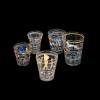Appendices
Figures
FIG. 1
The 20 representative objects from nine glassworking centers around which this e-book is centered.
FIG. 2
Pages 230 and 231 from William Gudenrath, “Techniques of Glassmaking and Decoration,” in Five Thousand Years of Glass, ed. Hugh Tait, London: British Museum Press, 1991. Photo: © The Trustees of the British Museum. Photo 121-136 taken by Steven Barall.
FIG. 3
Entrance area of exhibition Beyond Venice: Glass in Venetian Style, 1500–1750 at The Corning Museum of Glass, May 20–October 17, 2004. Photo: The Corning Museum of Glass.
FIG. 4
FIG. 5
FIG. 6
FIG. 7
Selection of scientific glassware made by William Gudenrath, borosilicate glass, flameworked. U.S., Houston, Texas, 1963–1967. H. (smallest) 8.5 cm. Photo: The Corning Museum of Glass.
FIG. 8
Giovanni Maria Butteri (Florentine, 1540–1606), The Medici Glass Workshop (detail). Palazzo Vecchio, Studiolo of Francesco I, 1570. Photo: Scala/Art Resource, NY.
FIG. 9
William Gudenrath working at wood-fired glassworking furnace in Velzeke, Belgium, September 2018. Photo: David Hill.
FIG. 10
FIG. 11
Selection of objects representing Venetian glass manufacture between about 1500 and 1750. They are positioned approximately in chronological order, from left to right. Tallest (second from left) 30 cm. The Corning Museum of Glass (76.3.17, purchased with funds from the Museum Endowment Fund; 2001.3.56, gift of Robert and Deborah Truitt; 84.3.24, purchased with funds from the Museum Endowment Fund; 2004.3.44; 2009.3.85; 60.3.17; 2000.3.11; 79.3.212, bequest of Jerome Strauss; 79.3.476, gift of The Ruth Bryan Strauss Memorial Foundation; 2000.3.5; 64.3.20; 79.3.363, gift of The Ruth Bryan Strauss Memorial Foundation; 2014.3.24, purchased in part with funds from Kenneth R. Treis; 60.3.57; 51.3.118; 2000.3.14; 53.3.47a, b; and 51.3.315). Photo: The Corning Museum of Glass.
FIG. 12
Paolo Veronese (1528–1588), The Wedding at Cana (detail). Venice, 1563. H. 6.7 m, W. 9.9 m. Musée du Louvre, Paris (inv. no. 142). Photo: © RMN-Grand Palais / Art Resource, NY.
FIG. 13
Ale glass, blown, applied, engraved. Low Countries, about 1670. H. 45.3 cm; Diam. (rim) 5.7 cm, (foot) 11.1 cm. The Corning Museum of Glass (79.3.252, bequest of Jerome Strauss). Photo: The Corning Museum of Glass.
FIG. 14
Tazza, vetro a retortoli. Venice, about 1550–1610. H. 13.8 cm; Diam. (rim) 15.5 cm, (foot) 7.8 cm. The Corning Museum of Glass (51.3.119). Photo: The Corning Museum of Glass.
FIG. 15
The Glass Room at Rosenborg Castle, Copenhagen, Denmark. Photo: Peter Nørby. The Royal Danish Collection, Rosenborg Castle.
FIG. 16
Glass goblets decorated with polychrome enamel. Venice, Muranese glass factory, about 1708. Rosenborg Castle, Copenhagen, Danske Kongers Kronologiske Samling. Photo: De Agostini Picture Library/Bridgeman Images.
FIG. 17
Group of goblets made by James Mongrain (American, b. 1968), 2009. H. (tallest) 36.3 cm. The Corning Museum of Glass (2009.4.46, .47, .45, .43, .51). Gift of the artist. Photo: The Corning Museum of Glass.
FIG. 18
Cadmium Yellow-Orange Venetian #398, blown with hot applications, manipulated while hot. U.S., Seattle, Washington, Dale Chihuly (American, b. 1941), 1990. H. 49 cm, W. 36.2 cm, D. 41.7 cm. The Corning Museum of Glass (90.4.129). Gift with funds from Mr. and Mrs. James R. Houghton. Photo: The Corning Museum of Glass.
FIG. 19
Conservative goblet design from the Bichierografia by Giovanni Maggi (1566–1618). Florence: Studio per Edizioni Scelte, 1977 (reprint of 1604 original), v. 1, p. 102. Photo: BIB 21317, Collection of the Rakow Research Library, The Corning Museum of Glass, with permission from Fondazione Memofonte.
FIG. 20
Fanciful vessel design from the Bichierografia by Giovanni Maggi (1566–1618). Florence: Studio per Edizioni Scelte, 1977 (reprint of 1604 original), v. 3, p. 206. Photo: BIB 21317, Collection of the Rakow Research Library, The Corning Museum of Glass, with permission from Fondazione Memofonte.
FIG. 21
Spiral thermometer. Florence, mid-17th century. H. 34(?) cm. Museo Galileo, Florence (193?). Photo: Franca Principe, Museo Galileo – Florence.
FIG. 22
Painting of Ferdinand II of Austria. Austria, Rudolfinische Hofkunst (?), about 1614. With frame: H. 147.5 cm, W. 112.5 cm. Kunsthistorisches Museum Vienna, Gemäldegalerie (inv. no. 3407). Photo: KHM-Museumsverband.
FIG. 23
Engraving believed to show Duke Ferdinand II flameworking. Rakow Research Library, The Corning Museum of Glass (121962).
FIG. 24
Group of dated polychrome enameled “peasant” glasses. Switzerland (perhaps exported from Germany or Bohemia), clockwise from top, left: 1743, 1755, 1792, 1721, and 1739. H. (tallest) 8 cm. The Corning Museum of Glass (79.3.734, gift of The Ruth Bryan Strauss Memorial Foundation; 75.3.142, gift of John B. Strater, Charles Helme Strater Jr., and Mrs. Margaret S. Robinson in memory of Charles Helme and Alice B. Strater; 61.3.175, gift of Minnie L. Schuelein; and 75.3.149 and 75.3.144, gifts of John B. Strater, Charles Helme Strater Jr., and Mrs. Margaret S. Robinson in memory of Charles Helme and Alice B. Strater). Photo: The Corning Museum of Glass.
FIG. 25
Vanitas still life with self-portrait of the young painter (detail). David Bailly (Dutch, 1584–1657), 1651. With frame: H. 118 cm, W. 150 cm. Museum De Lakenhal, Leiden, the Netherlands (inv. no. S 1351). Photo: Museum De Lakenhal, Leiden.
FIG. 26
Two Dom Pérignon champagne flutes made by the French glass manufacturer Baccarat. H. 23.4 cm, capacity 5.1 oz. Photo: Courtesy of Baccarat.
FIG. 27
Group of Spanish (probably Catalonian) Venetian-style objects: (left to right) goblet, covered goblet (confitero), and goblet, 1575–1699. Tallest: OH. 25.7 cm; Diam. (rim) 8.3 cm, (foot) 8.1 cm. The Corning Museum of Glass (60.3.86; 79.3.283, bequest of Jerome Strauss); 66.3.58, (gift of Jerome Strauss). Photo: The Corning Museum of Glass.


























